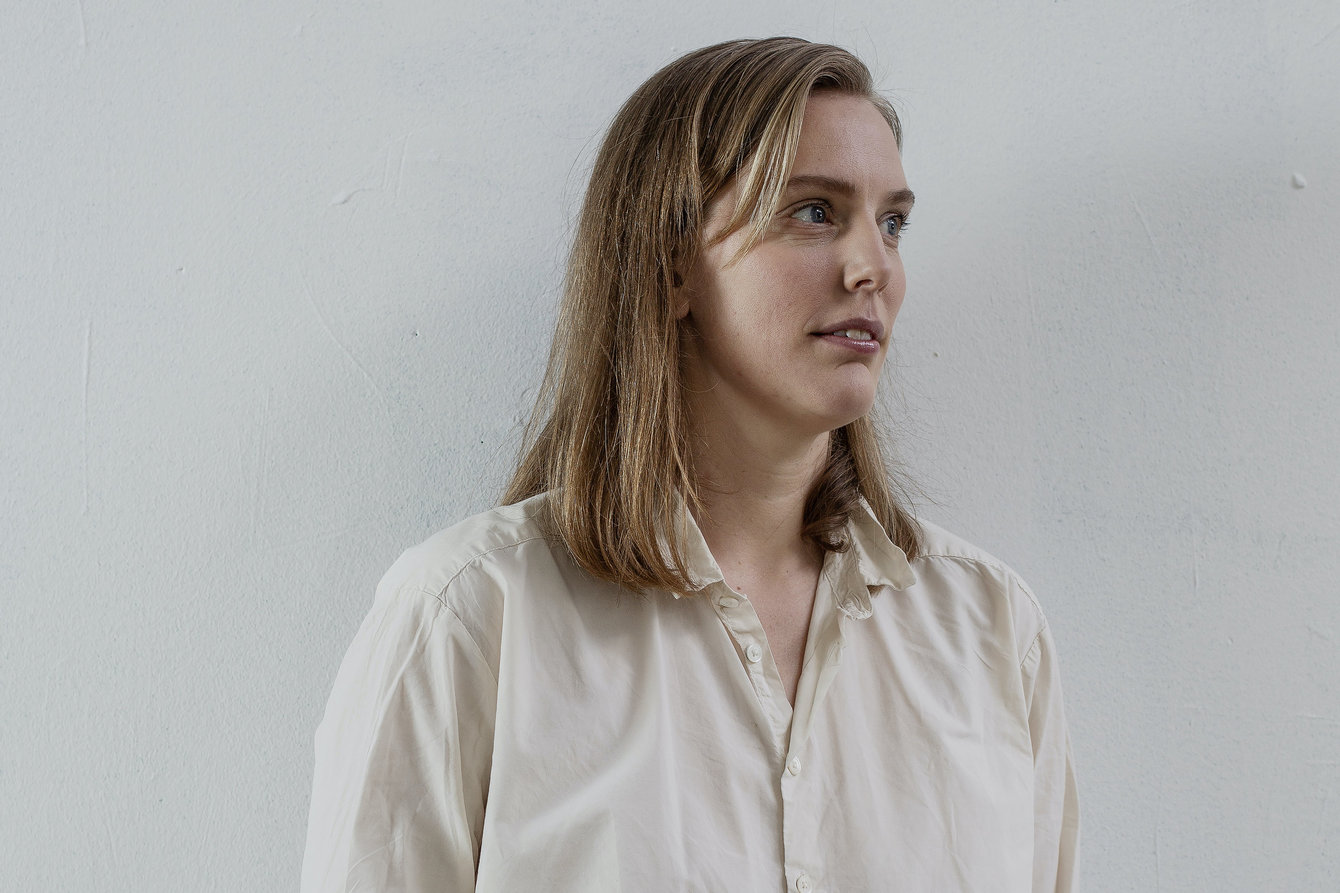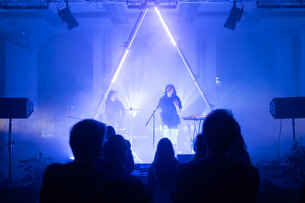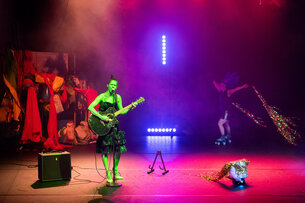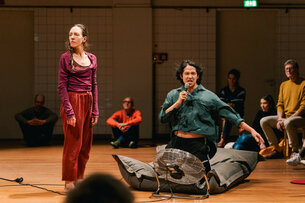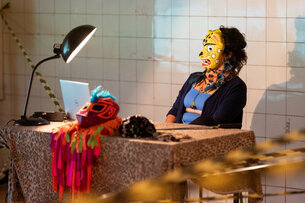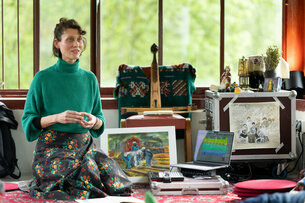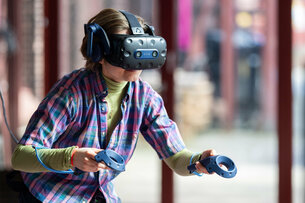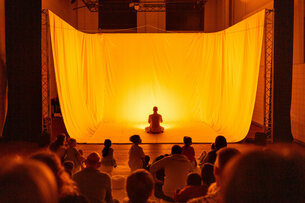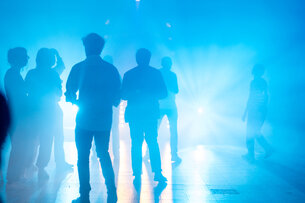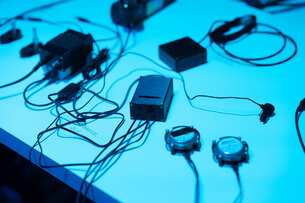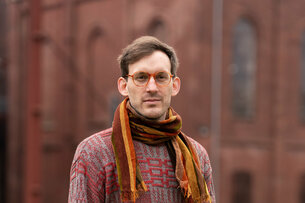»A good piece of music«
A conversation between Alma Söderberg, Hendrik Willekens & Gabriel Smeets
Themen
Bühne
Ein Gespräch zwischen Choreografin Alma Söderberg, Komponist Hendrik Willekens und Gabriel Smeets, ehemaliger künstlerischer Leiter von Cullberg, über ›The Listeners‹ (2020) und ›Noche‹ (2022).
Location: conference room ›The Birgit‹ at Cullberg, February 15, 2022.
Gabriel: Alma, I want to start with a remark that you made last week, of one of the reviews that is also referring to the end of The Listeners like this dusky atmosphere. You said »that is great that they saw this because that’s where Noche starts«. So my question is, is ›Noche‹ part two of ›The Listeners‹, and ›The Listeners‹ part one of ›Noche‹, and could we also say that ›The Listeners‹ is more daytime rhythm and ›Noche‹ more night rhythm?
Alma: Yes. ›The Listeners‹ is more the dusk, the twilight, the evening, going from day to night. In the piece the dancers are singing about »becoming one with the night«, there are a lot of references to the night in the text. Visually I feel that the lights, clothes, image but also more some kind of state of the piece, that the dancers are in, and the audience is in, is more soft. It is a sunset kind of vibe, lyrical and beautiful. From here I wanted to go deeper, into something where there is more risk involved, and more contrasts. I connected to both the desire to change the expression of the piece and to literally follow up ›The Listeners‹ with the night. I also had a very strong desire to work with syncopation. It is present in ›The Listeners‹ too but I thought it could become even more present in ›Noche‹. I started to read philiosophy about syncopation, a book by a French philosopher Catherine Clément who speaks about syncopation in relation to the night.
Gabriel: How is that relation, philosophy and syncopation?
Alma: It has to do with what you said, another kind of rhythm. That is the definition of syncopation, that it is a sudden rhythm or a sudden stop. There is also hard syncopation, and in medicine you speak about syncopation as a fault of a heartbeat, almost like a short death, and then you come back again. Clément relates it also to the night where other kinds of rhythms appear, an erratic rhythm, a spontaneous rhythm, or a rhythm not as planned. Clément looks at western philosophers and she claims that some of them has tried to tame syncopation, tried to avoid it, tried to create a system.
Gabriel: I was fortunate enough to watch ›The Listeners‹ a couple of times last week and the run of ›Noche‹ yesterday, and I suddenly had the feeling that ›Noche‹ is complex and multi layered. But there is also more danger. ›The Listeners‹ is safe, almost like the dancers are playful children, and now the same people are grown ups. The interesting thing for me is also that there is a kind of new thing in the movement material as far as I saw; a hip swing, that I don’t relate so much to you. I remember that you said to me already in December, »Bob Fosse movements« so there is also something jazzy coming in, something connected to the entertainment industry, like Broadway. Something that can be related to night clubs and to where things get a little bit more dark and obscure. Do you agree?
Alma: Yes, it does, but it is not something premeditated, it is more something that has grown by working together. I think the hip movements, but also the spine twists, and the slouched backs, make a »Bob Fosse feeling«. That comes from early on in the process when I thought I wanted to involve the spine and use the hips more. It has to do with the connection between music and sound and I wanted that to get closer to the dancers, getting it internalized into their bodies.
Gabriel: Interesting in the set up of ›Noche‹ are the standing microphones and lamps, like a stage on stage. It feels likes performing performativity, like awareness of performance but also getting lost in it or getting overwhelmed by it, that is something I find really beautiful in the whole set up.
Alma: In ›The Listeners‹ they are nine dancers on stage all the time, like a tableau, things appear and disappear. In ›Noche‹, in contrast to this, I wanted them to be more in singularity. This relates to syncopation, you can hear one person, and they are putting themselves at stake inside the work much more. So yes, it is indeed less safe, more risk and vulnerability but also more strength. In the beginning of the ›Noche‹ process we listened to and watched many things that inspire me, and then one of the dancers said that there is so much vulnerability and skill in a lot of the things I was showing them. I looked for that thing when someone is so sure of what they are doing that they are putting themself at stake and becoming more vulnerable. With ›The Listeners‹ the focus was on me meeting the company for the first time, making what comes out when my practice meets their practice. I listened to them and worked a lot with what they offered. With ›Noche‹ I wanted it to be more precise with what I relate to my practice prior to ›The Listeners‹.
Gabriel: A question for you, Hendrik; what were the key words, the input you as a composer got? What kind of thoughts and ideas did you discuss?
Hendrik: One of the first ideas and principles I worked with was strong contrasts. I started with sound design, looking for things with sharp edges, nothing fuzzy. ›The Listeners‹ is quite fuzzy and warm, with ›Noche‹ I went for a more cold and clear cut. That inspired me from the beginning. I fell in love with one of my oldest instruments again, a drum machine by a Swedish company called Elektron. The music for ›Noche‹ is almost completely made with that machine, pretty amazing if you ask me. Two musicians, Yatao Li and Justin Valer, each on different sides of the world, made new software for the drum machine on their free time. I had this idea of cold and contrast so I went towards a more digital approach, also as a contrast to ›The Listeners‹ which is very analogue. Just by association the night can be a more digital period.
Alma: You also worked with water images as an inspiration for the sound, images of moonlight reflecting in the water.
Hendrik: And drops, the cut is so clear, when a drop hits the surface.
Alma: Syncopation was also a theme for you. And you even went into surrealism.
Hendrik: Yes, usually we work with the dance, music and lights together. For ›Noche‹ the work has been much more modular. Pol (lighting designer) has made his thing, Behnaz (costume designer) hers. Especially Alma and I, are used to collaborate more, to grow the choreography together with the music. Now, I was sitting at my desk, in my office trying to imagine a piece, and imagine what music could be with that piece.
Alma: What is quite special with ›Noche‹ is that you made music based on a solo dance with Louise (dancer in Cullberg) which is very important, since it is the beginning of ›Noche‹. Louise did a dance on top of a straight beat, where I asked her to be syncopating. She was doing variations of rhythm, and then Hendrik watched the video and put sound to the movements. A track was born out of Louise’s movements. That was a beautiful start.
Hendrik: Yes, that was a big moment in the creation.
Alma: I want the audience to have that feeling, that the music was created to the dance movements, on the dancer, and not the other way around.
Gabriel: I know that you Hendrik use the words abstract and brainy about the music. That triggers me! How do you relate to that Alma? Is it also something that you are aiming for, that there are no references, no moves, no atmosphere, no emotions?
Alma: Hendrik and I have worked together for so long and we have a common aim which we probably define in different ways, but it is to make interesting music in the theatre. This is my main objective; »is this music good?«. So when Hendrik works with a drum machine we are both very wary so it does not become a manipulation, or bringing people to the club culture. We want to keep it interesting as a musical proposal all the time. I don’t work at all with narrative, even if there are images and associations coming up. What we both want to create is something that is happening here and now.
Gabriel: Is that because you want to keep it open rather than to put it in a frame? Chosing a title like ›Noche‹ in Spanish, however, brings something.
Alma: Yes, and I hesitated about the title. Most of my titles, like The Listeners, is about an action, it is more a »doing« than an image. So I was afraid of ›Noche‹ as a title, but Igor (dramaturge) convinced me, to go for it. For me it is interesting to change that, and for the first time to actually work with a starting point that has a lot of references and images, to see what I could do with that.
Gabriel: Trying to not have this atmosphere, mood, imagery, was it also hard to keep that out of the music when you started getting inspired by the movements and the images?
Hendrik: Things always get evoked. The starting points are formal ideas, like the idea of contrasts when it comes to the sound design. Maybe I can push that contrast when I start sequencing the music. I try to find games that work. And of course there are moody sounds in the end, but I don’t look for that and I don’t push that mood further. It is not only brainy, the music has physical aspects too. Alma and I feel the same about this; the dance performance is a »good piece of music«. We want to propose something unique, not using the frames or the genres that people recognize.
Alma: That is true, I think we work a lot like this both of us – conversations, concepts, and dialogues. Both of us have strong estetic ethics, looking for originality, being surprised with what we are creating is important to us. It is more about discovering.
Hendrik: We always have »a conversation« with the previous piece, like a reaction to it.
Gabriel: After four performances of ›The Listeners‹ in a row with different audiences, one thing that has surprised me is that no one has asked me »what is it about?«. Everybody seems to accept the fact that every understanding of it is ok. Amazing. Like when people go to an art gallery and watch an abstract painting you don’t ask what it is about, you just accept it although you might hate it, but you take it. And the other thing that I really like is the kinesthetic impression that this piece makes. When I sit high up in the auditorium I can see the audience move, and it is not only on the beat, but it is something that connects them to the piece. And of course this piece leaves you with a strong feeling. When the dancers stop making the sound but the rhythm is still in the body, also of the audience. Later, when we will present the two works together in a full evening, the audience and the dancers will go with that feeling into ›Noche‹, a strong beat that comes from ›The Listeners‹.
Alma: I have never made anything long. Everything has always been at a polite length, so I am really curious to see what happens if you are exposed to this sound and dance for much longer, to the two pieces in a row. That you have to stick with it a bit longer, see where it takes you.
Gabriel: Yes, me too, I am curious about it and I think it is really connected to the times we are living in. You created those pieces during the covid years and as an associated artist, you go from one thing into the next. So how much has time to do with it? That you had a longer period with the dancers, and the machinery of Cullberg. That you could create ›The Listeners› and then ›Noche‹ in close connection?
Alma: It comes from a desire to be in the theatre longer, to be immersed. What I longed for during the pandemic was to go to the theatre and stick with a piece, maybe see too much. I was longing for that way of feeling and being together with a performance, and it would be great to give this to the audience. I am so happy that I came to see ›The Listeners‹ in Stockholm last Friday because I was too much in my head, thinking the rehearsal time for ›Noche‹ is too short. But then I saw the dancers in ›The Listeners‹, and I felt it is going to be fine because they are already doing it, this is also ›Noche‹. I could see them in ›The Listeners‹ already implementing things we have been working on for ›Noche‹. They are finding more rhythm and more sharpness, going away from the blurry, fuzzy, lyrical and melodical, looking for edges and risks. They have grown to a place where they can do that, and take that further. The practice is the same; listening and sounding each other, making music with your body, this whole idea of making a piece of music together is the core of the practice.
Gabriel: The strange thing with ›The Listeners‹, and I see it also now with ›Noche‹, is that the dancers are so transparent when they are dancing. This fragility is actually a state that you have to be in in order to make that piece happen. I thought with these four shows of ›The Listeners‹ last week, that the dancers have found something, a kind of foundation how to make this piece happen. It is not a routine, it is still fragile, it can go wrong any second. But it is something that I really connect to you, to your practice, there are no guarantees. I liked what one reviewer wrote; that it looks like it is super easy but this takes so much work.
Alma: For me, that awareness is important. It is not only that it can break, because it probably will. From my experience of doing my solos I always loose control at some point, and I allow that to
happen, so that I in other moments can be completely carried by the practice. The dancers are starting to understand this, but I had to struggle a lot with them from the start, to understand that there is a range, from a place where you are totally in control and confident, to where it is fragile, where it could break. To go between those two I find interesting and I think that is what they have learnt. It is also necessary for the practice of listening because you need to also hear when you are making mistakes.
Gabriel: So that is actually the craft that you are working on? The craft that you can have awarness of when it is there and when it’s off, but it is still ok.
Alma: And even sometimes the off can be a proposal to something new, so when you arrive too late on the beat you create an upbeat. Coming too late or stumbling is a proposal for a new pattern, new dancer, new movement, new choreography, that’s also the practice of listening. The falter moments can be gifts, and that is also a way of creating choreography.
Gabriel: This is almost the complete philosophy of Social Choreography by Andrew Hewitt. He even uses the word »stumbling«, which in a social context is the moment where society shows how strong it can be or not. He discusses exactly this theory when the off beat becomes the upbeat for example.
Alma: Or actually it stays an off beat but it becomes an interesting rhythm.
Erica: How do you start to rehearse with a group of dancers, some that already know your practice, and some that are totally new to it?
Alma: I work a lot with the connection movement and sound, that is the core, all the time, my trick. So, experiencing your own movement as rhythm or as melody. That is the entrance. And then on top of that, a lot comes from seeing the rest of the group work, that is very clear with ›The Listeners‹. New people can enter because something is already happening between the others that you can tap into. I also believe in a kind of magic of the connection movement and sound.
Erica: Magic?
Alma: Like a trick… you put sound on a movement and it multiplies and a whole universe opens up because of this simple connection sound and movement. Also being on the beat and believing in the power of knowing exactly where the beat falls is important for noticing when you stumble and what kind of new rhythm that creates. And if you connect sound and movement you can also know when they are disconnected and you can play with that. Something to hold on to.
Gabriel: But it is a survival trick? It isn’t just fun, you need it?
Alma: It is a trick you need to listen, to notice, to be aware, to be attentive, it’s a trick for attention.
Gabriel: I find it interesting that inside, let’s call it rhythm, everything is already there so why would you need dramaturgy? What does dramaturgy mean when rhythm is already bringing so much? And how important is the order of things or colors or lights to you?
Alma: That is a good question. Sometimes I feel that everything should be taken away, to just keep sound, movement, dancers. I have made performances like that before. But at the same time I’m not an essentialist at all, I’m not a purist, so I think there is a lot to be found.
Gabriel: One last question. Working with this big group of dancers and this machinery of Cullberg will be over soon. Was it too much or was it ok for a while? I feel that with Cullberg you have been working on symphonies, a huge orchestra, and now you will go back to chamber music.
Alma: Yes, I think it will be very meaningful for me also in the longer perspective. In terms of what I’ve learnt in working with other people, a big group, it is very good. It is also difficult sometimes. I am still learning about leadership, being the person in the room that everybody looks to. But this collaboration has been incredibly inspiring.
Alma Söderberg
Swedish artist Alma Söderberg studied at The Royal Swedish Ballet School before leaving for Sevilla and Escuela de Danza de Matilde Coral to study flamenco. She completed her studies in contemporary dance, choreography and flamenco at the School for New Dance Development (SNDO) in Amsterdam in 2011. She is based in Malmö. Her works emerge out of a practice of setting different acoustic elements such as music, rhythm and singing in relation to dance and movement. A research of these expressions is constantly an ongoing part of Alma Söderberg’s artistry.
She is the recipient of several awards including the ITs Choreography Award (Amsterdam) for ›Entertainment‹ in 2009 and the ACT festival prize (Bilbao) for ›Cosas‹ in 2011. In 2010 she received together with Jolika Sudermann the Audience Award for ›Freedom of Speech‹ at the 100° Festival in Berlin and in 2013 the Stuttgart Dance and Theatre Award in the categories Audience Award and Special Award for an extraordinary performance. In 2016 she was awarded the Thalia Prize and The Birgit Cullberg Grant.
To date at PACT she has presented the performance ›Idioter‹ in 2014 - together with Hendrik Willekens, with whom she also initiated the music project wowawiwa - the German premiere of her solo ›Nadita‹ in 2016 and the world premiere of her most recent solo work ›Deep Etude‹ in 2018. In 2019 she presented the world premiere of ›Entangled Phrases‹, a trio with Anja Müller and Angela Peris Alcantud.
In 2020, she made her first collaboration with the renowned company Cullberg, that was shown at PACT: ›The Listeners‹. With 9 dancers, Söderberg explored the act of listening as an individual practice, a shared experience and a mutual perception.
Söderberg pursues her strong interests in music and collective work processes in the artist collective Manymore, which she co-founded, and as a member of John the Houseband, an art project that aims to bring together as many musical styles and instruments as possible and blur the boundaries between concert and performance, professionalism and amateurism, skills and dedication.
Cullberg
Cullbergbaletten is the leading repertoire company for contemporary dance in Sweden. The company is an important contributor to the international presentation of dance and choreography with tours all over the world. Cullbergbaletten works with a range of international choreographers and artists. The company currently has 16 dancers from nearly as many countries, and guest dancers are continuously invited to various projects. Since its inception the individual quality of each dancer has been Cullbergbaletten’s defining characteristic. By collaborating with choreographers and directors who are rooted in the contemporary field, Cullbergbaletten contributes strongly to the development of performing arts and dance as an art form. Cullbergbaletten’s activities encompass different projects and productions including workshops, conferences, seminars, and lectures. The directors are Gabriel Smeets and Stina Dahlström. Cullbergbaletten was founded in 1967 by Birgit Cullberg under the auspices of Riksteatern, the Swedish National Touring Theatre, of which it is still part.
